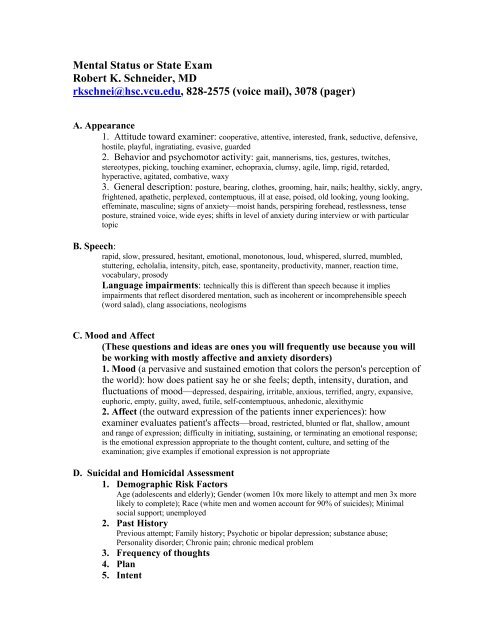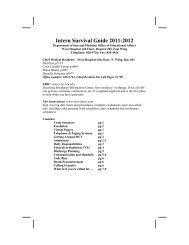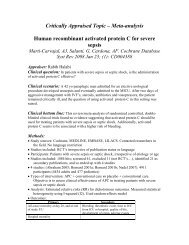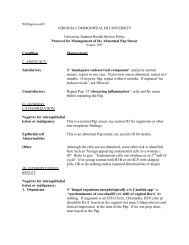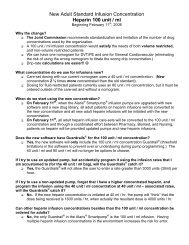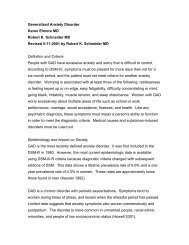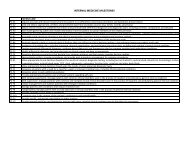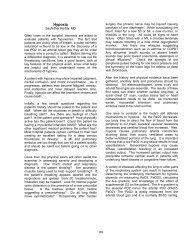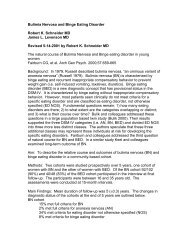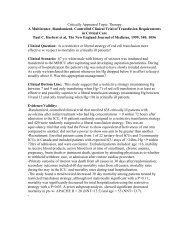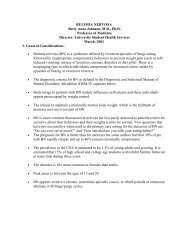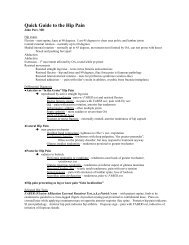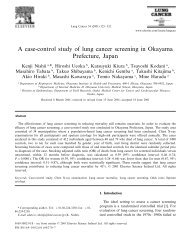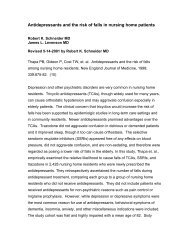Mental Status or State Exam
Mental Status or State Exam
Mental Status or State Exam
Create successful ePaper yourself
Turn your PDF publications into a flip-book with our unique Google optimized e-Paper software.
<strong>Mental</strong> <strong>Status</strong> <strong>or</strong> <strong>State</strong> <strong>Exam</strong><br />
Robert K. Schneider, MD<br />
rkschnei@hsc.vcu.edu, 828-2575 (voice mail), 3078 (pager)<br />
A. Appearance<br />
1. Attitude toward examiner: cooperative, attentive, interested, frank, seductive, defensive,<br />
hostile, playful, ingratiating, evasive, guarded<br />
2. Behavi<strong>or</strong> and psychomot<strong>or</strong> activity: gait, mannerisms, tics, gestures, twitches,<br />
stereotypes, picking, touching examiner, echopraxia, clumsy, agile, limp, rigid, retarded,<br />
hyperactive, agitated, combative, waxy<br />
3. General description: posture, bearing, clothes, grooming, hair, nails; healthy, sickly, angry,<br />
frightened, apathetic, perplexed, contemptuous, ill at ease, poised, old looking, young looking,<br />
effeminate, masculine; signs of anxiety—moist hands, perspiring f<strong>or</strong>ehead, restlessness, tense<br />
posture, strained voice, wide eyes; shifts in level of anxiety during interview <strong>or</strong> with particular<br />
topic<br />
B. Speech:<br />
rapid, slow, pressured, hesitant, emotional, monotonous, loud, whispered, slurred, mumbled,<br />
stuttering, echolalia, intensity, pitch, ease, spontaneity, productivity, manner, reaction time,<br />
vocabulary, prosody<br />
Language impairments: technically this is different than speech because it implies<br />
impairments that reflect dis<strong>or</strong>dered mentation, such as incoherent <strong>or</strong> incomprehensible speech<br />
(w<strong>or</strong>d salad), clang associations, neologisms<br />
C. Mood and Affect<br />
(These questions and ideas are ones you will frequently use because you will<br />
be w<strong>or</strong>king with mostly affective and anxiety dis<strong>or</strong>ders)<br />
1. Mood (a pervasive and sustained emotion that col<strong>or</strong>s the person's perception of<br />
the w<strong>or</strong>ld): how does patient say he <strong>or</strong> she feels; depth, intensity, duration, and<br />
fluctuations of mood—depressed, despairing, irritable, anxious, terrified, angry, expansive,<br />
euph<strong>or</strong>ic, empty, guilty, awed, futile, self-contemptuous, anhedonic, alexithymic<br />
2. Affect (the outward expression of the patients inner experiences): how<br />
examiner evaluates patient's affects—broad, restricted, blunted <strong>or</strong> flat, shallow, amount<br />
and range of expression; difficulty in initiating, sustaining, <strong>or</strong> terminating an emotional response;<br />
is the emotional expression appropriate to the thought content, culture, and setting of the<br />
examination; give examples if emotional expression is not appropriate<br />
D. Suicidal and Homicidal Assessment<br />
1. Demographic Risk Fact<strong>or</strong>s<br />
Age (adolescents and elderly); Gender (women 10x m<strong>or</strong>e likely to attempt and men 3x m<strong>or</strong>e<br />
likely to complete); Race (white men and women account f<strong>or</strong> 90% of suicides); Minimal<br />
social supp<strong>or</strong>t; unemployed<br />
2. Past Hist<strong>or</strong>y<br />
Previous attempt; Family hist<strong>or</strong>y; Psychotic <strong>or</strong> bipolar depression; substance abuse;<br />
Personality dis<strong>or</strong>der; Chronic pain; chronic medical problem<br />
3. Frequency of thoughts<br />
4. Plan<br />
5. Intent
6. Lethality of method<br />
7. Access to the method<br />
8. Any ideation of harm to others (frequent in domestic violence)<br />
E. Thinking and Perception<br />
(These questions arise when considering psychosis and some dementias)<br />
1. F<strong>or</strong>m of thinking<br />
a. Productivity: overabundance of ideas, paucity of ideas, flight of ideas, rapid thinking, slow<br />
thinking, hesitant thinking; does patient speak spontaneously <strong>or</strong> only when questions are asked,<br />
stream of thought, quotations from patient<br />
b. Continuity of thought: whether patient's replies really answer questions and are<br />
goal directed, relevant, <strong>or</strong> irrelevant; loose associations; lack of cause-and-effect relationships in<br />
patient's explanations; illogical, tangential, circumstantial, rambling, evasive, perseverative<br />
statements, blocking <strong>or</strong> distractibility<br />
2. Content of thinking<br />
a. Preoccupations: about the illness, environmental problems; obsessions, compulsions,<br />
phobias; obsessions <strong>or</strong> plans about suicide, homicide; hypochondriacal symptoms, specific<br />
antisocial urges <strong>or</strong> impulses<br />
3. Thought disturbances<br />
a. Delusions: content of any delusional system, its <strong>or</strong>ganization, the patient's<br />
convictions as to its validity, how it affects his <strong>or</strong> her life; persecut<strong>or</strong>y delusions—<br />
isolated <strong>or</strong> associated with pervasive suspiciousness; mood-congruent <strong>or</strong> mood-incongruent<br />
b. Ideas of reference and ideas of influence: how ideas began, their content, and<br />
the meaning the patient attributes to them<br />
4. Perceptual disturbances<br />
a. Hallucinations and illusions: whether patient hears voices <strong>or</strong> sees visions;<br />
content, sens<strong>or</strong>y system involvement, circumstances of the occurrence;<br />
hypnagogic <strong>or</strong> hypnopompic hallucinations; thought broadcasting<br />
b. Depersonalization and derealization: extreme feelings of detachment from self<br />
<strong>or</strong> from the environment<br />
5. Dreams and fantasies<br />
a. Dreams: prominent ones, if patient will tell them; nightmares<br />
b. Fantasies: recurrent, fav<strong>or</strong>ite, <strong>or</strong> unshakable daydreams<br />
F. Sens<strong>or</strong>ium and Cognition<br />
(These questions are all delirium and dementia, many are included in the MMSE)<br />
1. Alertness: awareness of environment, attention span, clouding of consciousness, fluctuations in<br />
levels of awareness, somnolesence, stup<strong>or</strong>, lethargy, fugue state, coma<br />
2. Orientation<br />
a. Time: whether patient identifies the day c<strong>or</strong>rectly; <strong>or</strong> approximate date, time of day; if in a<br />
hospital, knows how long he <strong>or</strong> she has been there; behaves as though <strong>or</strong>iented to the present<br />
b. Place: whether patient knows where he <strong>or</strong> she is<br />
c. Person: whether patient knows who the examiner is and the roles <strong>or</strong> names of the persons with<br />
whom in contact<br />
3. Concentration and calculation: subtracting 7 from 100 and keep subtracting 7s; if patient<br />
cannot subtract 7s, can easier tasks be accomplished—4 ´ 9; 5 ´ 4; how many nickels are in $1.35;<br />
whether anxiety <strong>or</strong> some disturbance of mood <strong>or</strong> concentration seems to be responsible f<strong>or</strong><br />
difficulty
4. Mem<strong>or</strong>y: impairment, eff<strong>or</strong>ts made to cope with impairment—denial, confabulation,<br />
catastrophic reaction, circumstantiality used to conceal deficit; whether the process of registration,<br />
retention, <strong>or</strong> recollection of material is involved<br />
a. Remote mem<strong>or</strong>y: childhood data, imp<strong>or</strong>tant events known to have occurred when the<br />
patient was younger <strong>or</strong> free of illness, personal matters, neutral material<br />
b. Recent past mem<strong>or</strong>y: past few months<br />
c. Recent mem<strong>or</strong>y: past few days, what did patient do yesterday, the day bef<strong>or</strong>e, have f<strong>or</strong><br />
breakfast, lunch, dinner<br />
d. Immediate retention and recall: ability to repeat six figures after examiner<br />
dictates them—first f<strong>or</strong>ward, then backward, then after a few minutes'<br />
interruption; other test questions; did same questions, if repeated, call f<strong>or</strong>th<br />
different answers at different times<br />
e. Effect of defect on patient: mechanisms patient has developed to cope with<br />
defect<br />
5. Fund of knowledge: level of f<strong>or</strong>mal education and self-education; estimate of the<br />
patient's intellectual capability and whether capable of functioning at the level of<br />
his <strong>or</strong> her basic endowment; counting, calculation, general knowledge; questions<br />
should have relevance to the patient's educational and cultural background<br />
6. Abstract thinking: disturbances in concept f<strong>or</strong>mation; manner in which the<br />
patient conceptualizes <strong>or</strong> handles his <strong>or</strong> her ideas; similarities (e.g., between<br />
apples and pears), differences, absurdities; meanings of simple proverbs, such as,<br />
"A rolling stone gathers no moss,” answers may be concrete (giving specific<br />
examples to illustrate the meaning) <strong>or</strong> overly abstract (giving generalized<br />
explanation); appropriateness of answers<br />
7. Insight: degree of personal awareness and understanding of illness<br />
a. Complete denial of illness<br />
b. Slight awareness of being sick and needing help but denying it at the same time<br />
c. Awareness of being sick but blaming it on others, on external fact<strong>or</strong>s, on<br />
medical <strong>or</strong> unknown <strong>or</strong>ganic fact<strong>or</strong>s<br />
d. Intellectual insight: admission of illness and recognition that symptoms <strong>or</strong><br />
failures in social adjustment are due to irrational feelings <strong>or</strong> disturbances, without<br />
applying that knowledge to future experiences<br />
e. True emotional insight: emotional awareness of the motives and feelings<br />
within, of the underlying meaning of symptoms; does the awareness lead to<br />
changes in personality and future behavi<strong>or</strong>; openness to new ideas and concepts<br />
about self and the imp<strong>or</strong>tant people in his <strong>or</strong> her life<br />
8. Judgment<br />
a. Social judgment: subtle manifestations of behavi<strong>or</strong> that are harmful to the<br />
patient and contrary to acceptable behavi<strong>or</strong> in the culture; does the patient<br />
understand the likely outcome of personal behavi<strong>or</strong> and is patient influenced by<br />
that understanding; examples of impairment
. Test judgment: patient's prediction of what he <strong>or</strong> she would do in imaginary<br />
situations; f<strong>or</strong> instance, what patient would do with a stamped, addressed letter<br />
found in the street<br />
Multiaxial Diagnosis<br />
Axis I: clinical syndromes (e.g., mood dis<strong>or</strong>ders, schizophrenia, generalized anxiety<br />
dis<strong>or</strong>der) and other conditions that may be a focus of clinical attention<br />
Axis II: personality dis<strong>or</strong>ders, mental retardation, and defense mechanisms<br />
Axis III: any general medical conditions (e.g., epilepsy, cardiovascular disease,<br />
endocrine dis<strong>or</strong>ders)<br />
Axis IV: psychosocial and environmental problems (e.g., div<strong>or</strong>ce, injury, death of a loved<br />
one) relevant to the illness<br />
Axis V: global assessment of functioning exhibited by the patient during the interview<br />
(e.g., social, occupational, and psychological functioning); a rating scale with a<br />
continuum from 100 (superi<strong>or</strong> functioning) to 1 (grossly impaired functioning) is used


